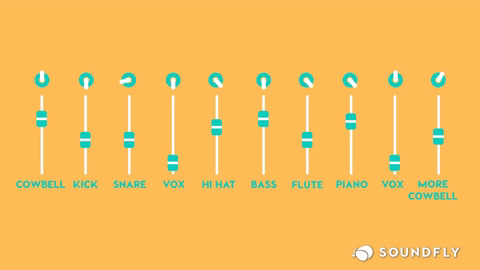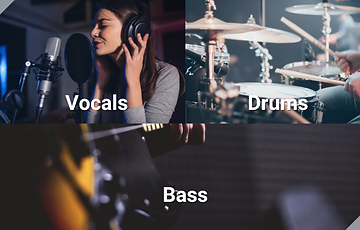
To put it bluntly, people don't know what are stems in music. As a mixing and mastering engineer, I hear the term thrown around incorrectly all the time. I typically bite my tongue as I'm trying to close a sale but it definitely makes my skin crawl.
In this article, I'll teach you the difference between multitracks and stems, the purposes of both, and when you would want to use each of them. You will learn proper terminology so you can communicate accurately with your engineer and the music community. Let's dig in and first look at what multitracks are.

Multitracks are a type of audio recording that allows for individual tracks to be recorded and mixed separately. This gives the engineer or producer more control over the finished product, as each track can be adjusted without affecting the others.
Multitracks are often used in recording studios, as they allow for a great deal of flexibility when mixing. However, they can also be used in live settings, such as when a band wants to record a live album. In this case, each instrument would be recorded on its own track, and then the tracks would be mixed together later.
Multitracks can be a great way to get more control over your recordings, and they can also help you create a better product in the end. No matter how they're used, multitracks are a valuable tool for audio engineers and producers.
Multitracks should be used when recording music so that you can capture every instrument on a separate track. This will give you the most control over mixing and give you the best end result. With the advancements of today and daws that support countless tracks, there is no reason to not take advantage of what technology has to offer.
Related Article: What Is Mixing In Music And Why It's Important For You To Know?

When it comes to music, the term "stem" refers to separate audio track grouping that contains a particular element of the song. For example, the vocal stem would contain only the vocals, while the drum stem would contain only the drums. In a typical song, there would be several different stems for all of the different instruments and elements.
One of the benefits of having stems is that it allows for more flexibility when mixing and mastering the song. For example, if the vocals are too loud, you can simply turn down the vocal stem without affecting the other elements of the song.
Setting up a workflow with stems is helpful to all audio engineers when it comes to session organization, mixing, and mastering music.
The main purpose of music stems are for mastering. Some mastering engineers like to work with stems as opposed to the 2-tracks and some don't. Also, music artists sometimes feel they get better results when doing stem mastering as opposed to standard mastering. We will discuss that later in this article.

If you are still confused, let's try to nail down the difference further. Stems and tracks (Mulitracks) are not the same. Stems are a subgroup of tracks as to where tracks are each individual instrument. An example of a stem would be all the vocal tracks mixed together into one track as to where a track would be the singular lead vocal track. Stems are always stereo tracks and tracks can be either stereo or mono.
Making a music stem will vary from daw to daw. However, it is typically a fairly easy process. For example, in Pro Tools, I would simply mute all the tracks that weren't relevant to the stem I wanted and then bounce the mix. That would give me a mix of all the tracks I want along with all their dynamic and time-based effects. Since we usually only make 3-5 stems this process doesn't take all that long. Easy breezy!
Mastering is the final step in the music production process. It's when you take your mixed and edited track and give it that professional polish that makes it sound ready for release. And while there are no hard and fast rules for mastering, there are some general guidelines you can follow to ensure your track sounds its best.
One key element of mastering is using stems. Stems are simply individual tracks that have been exported from your DAW. For example, if you have a drum track, a bass track, and a vocal track, those would each be considered a stem. By exporting stems, you give the mastering engineer more flexibility in terms of how they process each individual element of your track.
So, do you need stems for mastering? The short answer is no. If you're happy with your mixed track and it sounds ready for release, you can simply send the 2-track stereo file to the mastering engineer and they'll be able to do their job.
Related Article: What Is Audio Mastering & How Can Your Music Benefit From It?

There has been a recent trend of producers and DJs selling their music stems online. This has been a great way for them to make some extra money, as well as to get their music out to a wider audience. There are a number of different websites that allow you to sell your stems, and many of them are very easy to use. Some of these websites include Beatport, AirBit, and BeatStars.
However, before you start selling your stems, there are a few things you need to know. First, make sure you have the legal right to sell the stems. If you wrote and recorded the song yourself, then you likely have the legal rights to sell the stems. However, if you used samples or loops from other songs, you'll need to get permission from the copyright holders before you can sell the stems. Once you have the legal rights sorted out, you'll need to create stems that are high quality and noise-free.
So if you're looking to make some extra money from your music, selling stems is a great option.
Now you should know what are stems in music and understand the proper terminology to communicate accurately moving forward. Multitracks and stems both play an important role in the audio production process and now you know their differences. Lastly, I will leave you with my personal opinion that 2-track mastering is better than stem mastering. But, you'll have to find out my reasoning behind that in another article. Happy Mixing!
If you have gained some knowledge from this article, please consider subscribing to my blog for more music production tips, tricks, and advice!
"Some of the links within this article are affiliate links. These links are from various companies such as Amazon. This means if you click on any of these links and purchase the item or service, I will receive an affiliate commission. This is at no cost to you and the money gets invested back into Audio Sorcerer LLC."